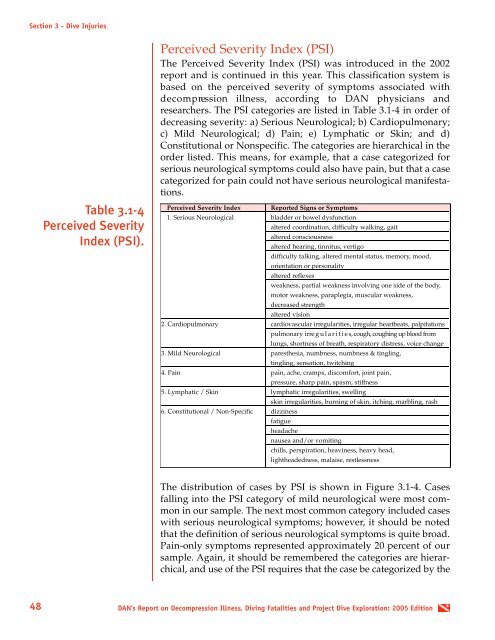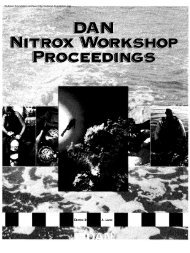Report on Decompression Illness, Diving Fatalities and Project Dive
Report on Decompression Illness, Diving Fatalities and Project Dive
Report on Decompression Illness, Diving Fatalities and Project Dive
- No tags were found...
You also want an ePaper? Increase the reach of your titles
YUMPU automatically turns print PDFs into web optimized ePapers that Google loves.
Secti<strong>on</strong> 3 - <strong>Dive</strong> InjuriesTable 3.1-4Perceived SeverityIndex (PSI).Perceived Severity Index (PSI)The Perceived Severity Index (PSI) was introduced in the 2002report <strong>and</strong> is c<strong>on</strong>tinued in this year. This classificati<strong>on</strong> system isbased <strong>on</strong> the perceived severity of symptoms associated withd e c o m p ressi<strong>on</strong> illness, according to DAN physicians <strong>and</strong>researchers. The PSI categories are listed in Table 3.1-4 in order ofdecreasing severity: a) Serious Neurological; b) Cardiopulm<strong>on</strong>ary;c) Mild Neurological; d) Pain; e) Lymphatic or Skin; <strong>and</strong> d)C<strong>on</strong>stituti<strong>on</strong>al or N<strong>on</strong>specific. The categories are hierarchical in theorder listed. This means, for example, that a case categorized forserious neurological symptoms could also have pain, but that a casecategorized for pain could not have serious neurological manifestati<strong>on</strong>s.Perceived Severity Index<str<strong>on</strong>g>Report</str<strong>on</strong>g>ed Signs or Symptoms1. Serious Neurological bladder or bowel dysfuncti<strong>on</strong>altered coordinati<strong>on</strong>, difficulty walking, gaitaltered c<strong>on</strong>sciousnessaltered hearing, tinnitus, vertigodifficulty talking, altered mental status, memory, mood,orientati<strong>on</strong> or pers<strong>on</strong>alityaltered reflexesweakness, partial weakness involving <strong>on</strong>e side of the body,motor weakness, paraplegia, muscular weakness,decreased strengthaltered visi<strong>on</strong>2. Card i o p u l m o n a r y c a rdiovascular irregularities, irregular heartbeats, palpitati<strong>on</strong>spulm<strong>on</strong>ary i r re g u l a r i t i e s, cough, coughing up blood fromlungs, shortness of breath, respiratory distress, voice change3. Mild Neurological paresthesia, numbness, numbness & tingling,tingling, sensati<strong>on</strong>, twitching4. Pain pain, ache, cramps, discomfort, joint pain,pressure, sharp pain, spasm, stiffness5. Lymphatic / Skin lymphatic irregularities, swelling6. C<strong>on</strong>stituti<strong>on</strong>al / N<strong>on</strong>-Specific dizzinessskin irregularities, burning of skin, itching, marbling, rashfatigueheadachenausea <strong>and</strong>/or vomitingchills, perspirati<strong>on</strong>, heaviness, heavy head,lightheadedness, malaise, restlessnessThe distributi<strong>on</strong> of cases by PSI is shown in Figure 3.1-4. Casesfalling into the PSI category of mild neurological were most comm<strong>on</strong>in our sample. The next most comm<strong>on</strong> category included caseswith serious neurological symptoms; however, it should be notedthat the definiti<strong>on</strong> of serious neurological symptoms is quite broad.Pain-<strong>on</strong>ly symptoms represented approximately 20 percent of oursample. Again, it should be remembered the categories are hierarchical,<strong>and</strong> use of the PSI requires that the case be categorized by the48DAN’s <str<strong>on</strong>g>Report</str<strong>on</strong>g> <strong>on</strong> Decompressi<strong>on</strong> <strong>Illness</strong>, <strong>Diving</strong> <strong>Fatalities</strong> <strong>and</strong> <strong>Project</strong> <strong>Dive</strong> Explorati<strong>on</strong>: 2005 Editi<strong>on</strong>
















